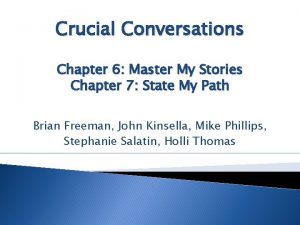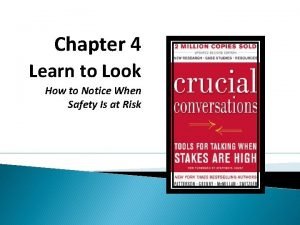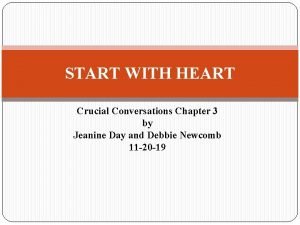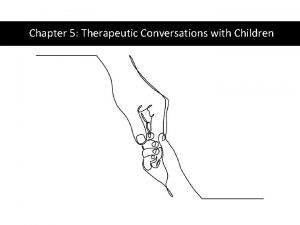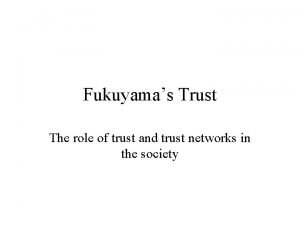Chapter 5 Therapeutic Conversations with Children Trust forms















- Slides: 15

Chapter 5: Therapeutic Conversations with Children

Trust forms over time, when children can “be sure of you” “Piglet sidled up to Pooh from behind. “Pooh, he whispered. “Yes Piglet? ” “Nothing, ” said Piglet, taking Pooh’s paw, “I just wanted to be sure of you. ” A. A. Milne

Qualities of Child-centered Conversations Patience Attention to Children’s Interests Invite active communication Validation Playfulness Attitude Actions Never Dismiss feelings Flexibility Express Genuine Curiosity Tolerance Humor

First encounters should be positive and hopeful with the singular goal of children returning for a second conversation.

Confidentiality is an ethic of social work practice. Childcentered workers must inform and remind younger children that they regularly speak with their parents and caregivers.

Society for Adolescent Medicine (SAM) “Individual adolescents vary in their levels of psychosocial maturity and economic independence, as well as in their behaviors and family situations. Therefore, it is inappropriate to apply a single moral prescription in all cases. The protection of confidentiality in adolescent health care should be grounded in the moral principle of respect for autonomy, but must recognize that in specific circumstances it may be permissible or even necessary to breach confidentiality to further other important moral principles, such as beneficence or nonmalificence. ”

Sadie

Identify: Barriers Assumptions Recognize: Child Development Factors Parent Expertise Use : Child-centered Language & Communication Descriptive Reports Preparation for First Conversations

Difficult Conversations

Non-verbal Communication

Art as Communication

Reflective Practice

Kahlila Johnson, Age 4

Case Note Child and Family Se Division rvices Of of the De fice partment of Health Human S & ervices To Whom it May Co ncern: Re: Kahli la Johnso n DOB: 2 -0 5 -2007 I met wit h Kahlila Joh her moth er Mrs. M nson, age 4, and oni their hom e on 32 S ca Johnson in tuyvesan Gustav S t Way. tone, 13, Mrs. John from a pr son’s son evious re lationship available , was not to be inte r v Johnson a iewed. T he partment was smal but clutte l, c red. Mrs. Johnson w lean friendly a as nd did no t interfer visitation e with th and child e i n interview. The took plac e in the c bedroom hild’s. Ka avoided m hlila had little to say. She ost quest ions and used her

1. 2. Conversation Starters 3. 4. Identify qualities of communication that contributed to the worker’s first meeting with Kahlila and Mrs. Johnson. Offer critique on ways the worker might have improved communication. What worker-related factors influenced this first session outcome? What are your suggestions for preparing for a first-time meeting? Sadie’s case presents an ethical dilemma surrounding disclosure of confidential information. Would you have made the same decisions? Art exercise: Using either Sadie’s or Kahlila’s case vignette, draw or write a reflective response. Indicate whose perspective you’re representing – the worker’s, the client’s, or your own.
 Northern trust charitable trust
Northern trust charitable trust Crucial conversations chapter 5
Crucial conversations chapter 5 Crucial conversations chapter 6 summary
Crucial conversations chapter 6 summary Crucial conversations chapter 7
Crucial conversations chapter 7 Crucial conversations learn to look
Crucial conversations learn to look Conversation
Conversation Start with the heart crucial conversations
Start with the heart crucial conversations Therapeutic exercise chapter 1 mcqs
Therapeutic exercise chapter 1 mcqs Chapter 4 therapeutic communication skills
Chapter 4 therapeutic communication skills Chapter 2 multicultural therapeutic communication
Chapter 2 multicultural therapeutic communication Why are related forms more agreeable than unrelated forms
Why are related forms more agreeable than unrelated forms Long forms short forms
Long forms short forms Why are related forms more agreeable than unrelated forms
Why are related forms more agreeable than unrelated forms Why are related forms more agreeable than unrelated forms?
Why are related forms more agreeable than unrelated forms? Deteriminer
Deteriminer Constructive structure in asl
Constructive structure in asl



